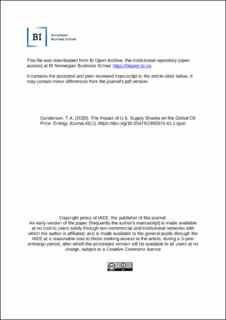| dc.contributor.author | Gundersen, Thomas Størdal | |
| dc.date.accessioned | 2020-02-26T09:23:35Z | |
| dc.date.available | 2020-02-26T09:23:35Z | |
| dc.date.created | 2020-01-14T14:32:23Z | |
| dc.date.issued | 2020 | |
| dc.identifier.citation | The Energy Journal. 2020, 41(1) | en_US |
| dc.identifier.issn | 0195-6574 | |
| dc.identifier.uri | https://hdl.handle.net/11250/2643794 | |
| dc.description.abstract | I examine the role of the U.S. shale oil boom in driving global oil prices. Using a structural vector autoregressive (SVAR) model that identifies separate oil supply shocks for the U.S. and OPEC, I find that U.S. supply shocks can account for up to 13% of the oil price variation over the 2003-2015 period. This is considerably more than what has been found in other studies. Moreover, while U.S. oil production has increased substantially since 2010, U.S. oil supply shocks first started to contribute negatively to oil prices beginning in late 2013. This mismatch implies a temporary friction in the transmission of U.S. supply shocks to the rest of the world likely caused by logistical and technological challenges observed in the downstream supply chain. | en_US |
| dc.language.iso | eng | en_US |
| dc.publisher | IAEE | en_US |
| dc.rights | Navngivelse 4.0 Internasjonal | * |
| dc.rights.uri | http://creativecommons.org/licenses/by/4.0/deed.no | * |
| dc.title | The Impact of U.S. Supply Shocks on the Global Oil Price | en_US |
| dc.type | Peer reviewed | en_US |
| dc.type | Journal article | en_US |
| dc.description.version | acceptedVersion | en_US |
| dc.subject.nsi | VDP::Samfunnsøkonomi: 212 | en_US |
| dc.subject.nsi | VDP::Economics: 212 | en_US |
| dc.source.volume | 41 | en_US |
| dc.source.journal | Energy Journal | en_US |
| dc.source.issue | 1 | en_US |
| dc.identifier.doi | 10.5547/01956574.41.1.tgun | |
| dc.identifier.cristin | 1772559 | |
| cristin.unitcode | 158,3,0,0 | |
| cristin.unitname | Institutt for samfunnsøkonomi | |
| cristin.ispublished | true | |
| cristin.qualitycode | 2 | |

